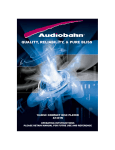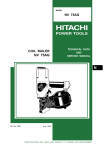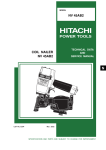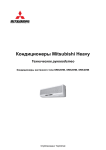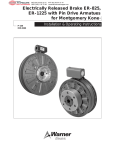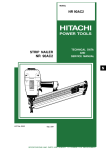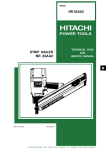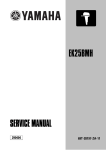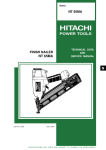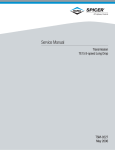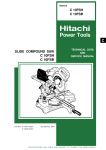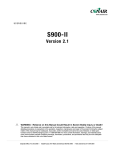Download Senco COIL NAILERS SCN65 Technical data
Transcript
MODEL NV 83A2 POWER TOOLS COIL NAILER NV 83A2 TECHNICAL DATA AND SERVICE MANUAL N LIST No. E007 Oct. 2002 SPECIFICATIONS AND PARTS ARE SUBJECT TO CHANGE FOR IMPROVEMENT REMARK: Throughout this TECHNICAL DATA AND SERVICE MANUAL, a symbol(s) is(are) used in the place of company name(s) and model name(s) of our competitor(s). The symbol(s) utilized here is(are) as follows: Competitors Symbols Utilized Company Name Model Name R SENCO SCN65 Y PASLODE P350C P BOSTITCH N80CB CONTENTS Page 1. PRODUCT NAME ..................................................................................................................... 1 2. MARKETING OBJECTIVE ....................................................................................................... 1 3. APPLICATIONS ........................................................................................................................ 1 4. SELLING POINTS .................................................................................................................... 1 5. SPECIFICATIONS .................................................................................................................... 3 5-1. Specifications ........................................................................................................................... 3 5-2. Nail Selection ........................................................................................................................... 4 5-3. Nail Driving Force .................................................................................................................... 5 5-4. Optional Accessories ............................................................................................................... 6 6. COMPARISONS WITH SIMILAR PRODUCTS ........................................................................ 7 7. PRECAUTIONS IN SALES PROMOTION ............................................................................... 8 7-1. Instruction Manual ................................................................................................................... 8 7-2. Warning Label .......................................................................................................................... 8 7-3. Related Laws and Regulations ................................................................................................ 9 7-4. Precautions in Operation ......................................................................................................... 9 8. MECHANISM AND OPERATION PRINCIPLE ....................................................................... 10 8-1. Mechanism ............................................................................................................................ 10 8-2. Interchangeability of Parts ...................................................................................................... 11 8-3. Operation Principle ................................................................................................................ 13 9. TROUBLESHOOTING GUIDE ............................................................................................... 17 9-1. Troubleshooting and Correction ............................................................................................. 17 9-2. Possible Causes and Corrections of Air Leakage .................................................................. 22 10. DISASSEMBLY AND REASSEMBLY .................................................................................. 25 10-1. General Precautions in Disassembly and Reassembly ....................................................... 25 10-2. Disassembly and Reassembly of the Output Section .......................................................... 26 10-3. Disassembly and Reassembly of the Control Valve Section ............................................... 28 10-4. Disassembly and Reassembly of the Magazine Section ..................................................... 29 10-5. Disassembly and Reassembly of the Driving Section ......................................................... 32 10-6. Grip Rubber ......................................................................................................................... 36 11. INSPECTION AND CONFIRMATION AFTER REASSEMBLY ............................................ 37 12. STANDARD REPAIR TIME (UNIT) SCHEDULES ............................................................... 38 Assembly Diagram for NV 83A2 1. PRODUCT NAME Hitachi 83 mm Coil Nailer, Model NV 83A2 2. MARKETING OBJECTIVE The current Model NV 83A is a well-reputed 3-1/4 coil nailer suitable for framing works. However, the coil nailer market is becoming increasingly competitive. The newly introduced Model NV 83A2 is developed by making minor changes to the current Model NV 83A to meet the market demands. The output section is common to that of the Model NV 83A featuring good driving response. In addition, the Model NV 83A2 is equipped with a tool-less nailing depth adjuster, pop-out magazine, non-slip rubber, etc. to meet the market demands. Applicable nails are the same as those of the Model NV 83A. The Model NV 83A2 weighs only 3.7 kg (same as the Model NV 83A). 3. APPLICATIONS Construction of wooden work such as floor and wall framing, roof decking and subflooring Mobile and modular home construction Making wooden boxes, palletes, and drums Packing operations in manufacturing plants, and other types of packing and crating work in general 4. SELLING POINTS Quick driving 2-valve cylinder drive system Grip rubber Easy top load pop-out magazine Tool-less adjuster --- 1 --- (1) Output section The basic construction is the same as that of the Model NV 83A except the 2-valve cylinder drive system that is well reputed for quick driving is adopted. (2) Adjuster While the Model NV 83A requires a wrench to adjust the nailing depth, the Model NV 83A2 requires no tool for adjustment. Amount of adjustment is about 4.5 mm (0.177"). Flush Shallow Too deep Too shallow Deep Adjuster (3) Magazine While the Model NV 83A is equipped with a bottom loading magazine, the Model NV 83A2 is equipped with the "pop-out magazine" that allows easy nail loading from the top of the magazine thanks to the tilting nail holder. The magazine can be opened/closed just by the nail guide operation. (The Model NV 83A requires operation of both the nail guide and the latch at the rear of the magazine.) (4) Handle grip Thanks to the adoption of the grip rubber that is common to the Model NR 83AA2, the handle grip of the Model NV 83A2 is more durable than that of the Model NV 83A. --- 2 --- 5. SPECIFICATIONS 5-1. Specifications NV 83A2 Model Driving system Reciprocating piston type Operating pressure 5 --- 8.5 kgf/cm2 (70 --- 120 psi, 4.9 --- 8.3 bar) (Gauge pressure) Driving speed Min. 3 pcs./sec. Weight 3.7 kg (8.2 lbs.) Dimensions (Length x height x width) 290 mm x 348 mm x 135 mm (11-13/32" x 13-11/16" x 5-13/32") Nail feed system Reciprocating piston type Nail capacity 200 --- 300 nails (1 coil) Air consumption 2.4 ltr/cycle at 7 kgf/cm2 (.085 ft3/cycle at 100 psi) (2.4 ltr/cycle at 6.9 bar) Air inlet 3/8 NPT thread Packaging Corrugated cardboard box Package dimensions (Length x height x width) 396 mm x 143 mm x 366 mm (15-19/32" x 5-5/8" x 12-39/64") Standard accessories Hex. bar wrench for M5 screw (Code No. 944458) .................................... 1 Hex. bar wrench for M6 screw (Code No. 944459) .................................... 1 Hex. bar wrench for M8 screw (Code No. 872422) .................................... 1 Eye protection (Code No. 875769) ............................................................. 1 Optional accessories Sequential trip mechanism kit (single-shot) (Code No. 876762) Pneumatic tool lubricant (1 oz oil feeder) (Code No. 877153) Pneumatic tool lubricant (4 oz oil feeder) (Code No. 874042) Pneumatic tool lubricant (1) (Code No. 876212) --- 3 --- 5-2. Nail Selection The Model NV 83A2 utilizes common round-head nails collated by wire or sheet into coils from 200 to 300 pieces. Applicable nail dimensions are shown below. However, it is recommended to use genuine HITACHI nails to ensure satisfactory driving quality. CAUTION: Ensure that nails are as specified in Fig. 1. Other nails will cause clogging of nails and subsequent damage to the nailer. NOTE: Aluminum nails may bend when driven into a hard workpiece. Test before use. Wire-collated nails Max. Min. 2.5 mm (.099") Fig. 1 Dimensions of nails --- 4 --- 7.2 mm (.283") 83 mm (3-1/4") 50 mm (2") 6 mm (.236") 3.3 mm (.131") 5-3. Nail Driving Force Fig. 2 shows by type of wood and nail, the nailer output energy provided by the supply pressure and the nailing energy required for driving the nail flush. Air pressure which exceeds the intersecting point between the nailer output energy and the nailing energy required for driving the nail allows the nail to be fully driven. For example, when driving a nail of 3.3 mm dia. by 83 mm length (0.131" x 3-1/4") into nine sheets of 12 mm plywood (108 mm thick) with the Model NV 83A2, a pressure of about 7.0 bar (7.1 kgf/cm2, 102 psi) allows the nailer to drive the nail flush with the wood surface. A pressure beyond this value causes the nail head to be driven below the wood surface. Fig. 2 should be used as reference data because those values vary depending on the type, moisture content, and grain of wood. Y NV 83A2 NV 83A, R, P NV 83A2 Fig. 2 Required nailing energy and nailer output energy --- 5 --- 5-4. Optional Accessories Sequential trip mechanism kit (Single shot) (Code No. 876762) A sequential trip mechanism kit is provided as an optional accessory for the Model NV 83A2. By using this optional accessory, a nail is driven by pressing the pushing lever first against a workpiece and then pulling the trigger (single-shot operation), and no nail is driven when pulling the trigger first and then pressing the pushing lever against a workpiece. Please recommend the sequential trip mechanism kit to the customers who want to use it. Salespersons must instruct the customers to read the Handling Instructions attached to the sequential trip mechanism kit and also the Handling Instructions of the Model NV 83A2 thoroughly for correct use. --- 6 --- --- 7 --- 8.4 lbs. (3.8 kg) 8.2 lbs. (3.7 kg) 8.2 lbs. (3.7 kg) Weight 2.5 mm -- 3.3 mm (0.098" -- 0.120") 50 mm -- 83 mm (2" -- 3-1/4") 2.5 mm -- 3.3 mm (0.098" -- 0.120") 50 mm -- 83 mm (2" -- 3-1/4") Shank dia. Length 38 mm -- 83 mm (1-1/2" -- 3-1/4") 2.5 mm -- 3.8 mm (0.098" -- 0.150") 38 mm -- 83 mm (1-1/2" -- 3-1/4") 2.5 mm -- 3.3 mm (0.098" -- 0.120") Wire Wire Wire Wire Applicable nails Rubber Rubber Rubber Racket grip Rubber Handle grip 50 mm -- 90 mm (2" -- 3-1/2") 2.5 mm -- 3.3 mm (0.098" -- 0.120") Wire 1-valve 1-valve 1-valve 2-valve 2-valve Trigger valve Collation Tool not required Tool required None Top loading (Plastic) 225 --- 275 nails 2.5 ltr/cycle (0.089 ft3/cycle) With wrench Top loading (Plastic) 225 --- 275 nails 2.7 ltr/cycle (0.096 ft3/cycle) 327 mm x 359 mm x 111 mm (12-7/8" x 10-9/64" x 4-3/8") 8.2 lbs. (3.7 kg) 4.9 --- 8.3 bar (5 --- 8.5 kgf/cm2) (70 --- 120 psi) R Tool not required Driving depth adjustment mechanism Top loading (Plastic) Magazine type (Material) Top loading (Plastic) 225 --- 300 nails 200 --- 300 nails 200 --- 300 nails Nail capacity Bottom loading (Plastic) 2.6 ltr/cycle (0.093 ft3/cycle) 2.2 ltr/cycle (0.078 ft3/cycle) 2.2 ltr/cycle (0.078 ft3/cycle) Air consumption at 7 kgf/cm2 (100 psi) Dimensions (L x H x W) 8.4 lbs. (3.8 kg) 4.9 --- 8.3 bar (5 --- 8.5 kgf/cm2) (70 --- 120 psi) Y 290 mm x 348 mm x 135 mm 290 mm x 348 mm x 135 mm 306 mm x 330 mm x 141 mm 330 mm x 325 mm x 132 mm (11-13/32" x 13-11/16" x 5-13/32") (11-13/32" x 13-11/16" x 5-13/32") (12-3/64" x 13" x 5-35/64") (13" x 9-51/64" x 5-13/64") 4.9 --- 6.9 bar (5 --- 7 kgf/cm2) (70 --- 100 psi) 4.9 --- 8.3 bar (5 --- 8.5 kgf/cm2) (70 --- 120 psi) 4.9 --- 8.3 bar (5 --- 8.5 kgf/cm2) (70 --- 120 psi) P Operating pressure Model name NV 83A HITACHI NV 83A2 Maker 6. COMPARISONS WITH SIMILAR PRODUCTS 7. PRECAUTIONS IN SALES PROMOTION In the interest of promoting the safest and most efficient use of the Model NV 83A2 Nailer by all of our customers, it is very important that at the time of sale the salesperson carefully ensures that the buyer seriously recognizes the importance of the contents of the Instruction Manual, and fully understands the meaning of the precautions listed on the Warning Label attached to each tool. The Model NV 83A2 Nailer is designed for continuous nail driving. At time of sale, the salesperson must inform the customer that the sequential trip mechanism kit which can change the Model NV 83A2 to a single-shot nailer is optionally available, and recommend it to the customers who want to use it. Refer to the leaflet attached together with the Instruction Manual for details. 7-1. Instruction Manual Although every effort is made in each step of design, manufacture, and inspection to provide protection against safety hazards, the dangers inherent in the use of any pneumatic tool cannot be completely eliminated. Accordingly, general precautions and suggestions for use of pneumatic tools, and specific precautions and suggestions for the use of the pneumatic nailer are listed in the Instruction Manual to enhance the safe, efficient use of the tool by the customer. Salespersons must be thoroughly familiar with the contents of the Instruction Manual to be able to offer appropriate guidance to the customers during sales promotion. 7-2. Warning Label Each Model NV 83A2 unit is provided with a Warning Label (illustrated below) which lists basic safety precautions in its use. Carefully ensure that customers fully understand and follow these precautions before using the tool. PROTECTION --- 8 --- 7-3. Related Laws and Regulations As nailers and staplers are designed to instantaneously drive nails and staples, there is an ever-present danger of misfiring and subsequent possible serious injury. Accordingly, close attention in handling is absolutely necessary at all times. Carefully ensure that the customer is fully aware of the precautions listed in the Instruction Manual provided with each unit. While there are no specific safety regulations, there are related items in various general safety regulations with which the salespersons should be familiar in order to properly advise the customer. Please check your national and/or local regulations for applicable items. Some applicable items are outlined below. The U.S.A: OSHA 1926.102 Eye and face protection 1926.302 Power-operated hand tools ANSI SNT-101-1993 Portable, Compressed-Air-Actuated, Fastener Driving Tools-Safety Requirements for 7-4. Precautions in Operation (1) Pay special attention to the pressure, capacity and piping of the air compressor in order to keep the air pressure supplied to the Model NV 83A2 within the range from 5 kgf/cm2 (70 psi, 4.9 bar) to 8.5 kgf/cm2 (120 psi, 8.3 bar). Otherwise, ill effect may be given to the performance, service life and safety of the Model NV 83A2. (Be sure to install a regulator when using a high-pressure air compressor whose set pressure is 10 kgf/cm2 (140 psi, 9.8 bar) or more. In this case, adjust the air pressure at 8.5 kgf/cm2 (120 psi, 8.3 bar) or less.) (2) If dust in the compressed air settles on the sliding portion, the Model NV 83A2 will not operate properly. Lubrication is effective to remove dust and also to prolong the service life of the Model NV 83A2 keeping good performance. It is recommended to lubricate the Model NV 83A2 daily. Supply 5-10 drops of lubricant into the air plug on the Model NV 83A2. When not in use for an extended period, supply lubricant and perform idle driving two or three times to lubricate the inside, then apply a thin coat of the lubricant to the steel parts to avoid rusting. Usable lubricant is specified in the following table. Please recommend the customers to use Hitachi nailer/ tacker oil. Type of oil Hitachi Pneumatic Tool Lubricant Brand or product name Shell sliding oil, Tonna S32 (Old Tonna T32); Code No. 877153 (1 oz. oil feeder) Code No. 874042 (4 oz. oil feeder) Code No. 876212 (1L (1 quart) can) (3) Be sure to drain the tank of the compressor securely to prevent deteriorated performance or malfunction of the Model NV 83A2 due to rusting. (4) Instruct the customers (especially the heavy users) to perform inspection and maintenance securely. --- 9 --- 8. MECHANISM AND OPERATION PRINCIPLE 8-1. Mechanism As illustrated in Fig. 3, the Model NV 83A2 can be generally divided into four sections: output section, control valve section, driving section and magazine section. Although the output section and the valve section are basically common to those of the Model NV 83A, most of the parts of the driving section and the magazine section have been newly designed. Primary differences from the Model NV 83A are described below. Output section ................... The handle employs a grip rubber (Model NV 83A grip tape). Driving section .................... The tail cover, nail guide shaft, etc. have been newly designed to adopt the toolless adjuster. Magazine section ................ Most of the parts of the magazine section have been newly designed to make the magazine top-loading type. Exhaust Valve [9] Exhaust vent Accumulator Head Cap and Gasket Set [10] Output section Safety valve portion Exhaust Cover [4] Control valve section Trigger valve portion Piston (H) [12] Cap [46] Air inlet Cylinder Ring [19] Cylinder [17] Driver blade Magazine section Air return chamber Piston Bumper (B) [29] Driving section Adjuster [39] Magazine Cover [84] A Tail Cover [31] Nail Holder [87] Magazine [81] Section A - A Guide Lock [97] Pushing Lever [54] Feeder Set [35] Fig. 3 Construction --- 10 --- Nail Guide [95] Feeder Piston [70] 8-2. Interchangeability of Parts The driving section and the magazine section are not interchangeable between the Model NV 83A2 and the NV 83A because these sections of the Model NV 83A2 have been newly designed. The output section and the control valve section are interchangeable except the following parts. Part NV 83A2 NV 83A Pisotn Bumper (B) [29] 8.3 mm dia. 10 mm dia. Large hole dia. Hex. Socket Hd. Bolt (W/Flange) M6 x 45 [1] (for mounting the Top Cover [2]) Hex. Socket Hd. Bolt (W/Flange) M6 x 45 [1] M6 x25 Spring washer Top Cover [2] Hex. Socket Hd. Bolt (W/Sp. Washer) M6 x 25 [3] (for mounting the Exhaust Cover [4]) Hex. Socket Hd. Bolt (W/Sp. Washer) M6 x 25 [3] M6 x25 Spring washer Exhaust Cover [4] Tail Cover [31] Boss Hole Tail Cover [31] Nail Guide [95] Flat --- 11 --- Part NV 83A2 NV 83A Pushing Lever [54] Bent. Welded. Cover [105] --- 12 --- 8-3. Operation Principle (1) When the compressed air source (air hose) is connected to the nailer: Air pressure is applied to the lower surfaces of the flanges located at the center portion of the cylinder, forcing the cylinder upward. The compressed air is thereby blocked from the upper end of the cylinder, and no pressure is applied to the Piston. The accumulator is filled with compressed air. The trigger and pushing lever are not operated, and remain closed. The exhaust vents are open, and no air pressure is applied to the valve and feed piston air passage. Fig. 4 --- 13 --- (2) When the trigger and pushing lever are operated: Cylinder ring (D) Although air pressure is applied to both the upper and lower surfaces of the cylinder, the cylinder is forced downward due to the larger effective area of the upper surface. Accordingly, the upper portion of the cylinder is opened, and the compressed air forces the piston downward. (D) Compressed air is applied to the upper side of the exhaust valve, forcing it downward and closing the exhaust vent. (B) When the trigger and pushing lever are operated simultaneously, the safety valve and trigger valve are opened. (A) The trigger and pushing lever are operated simultaneously. (Note) If either the trigger or pushing lever are operated individually, compressed air will not enter the valve air passage, and the nailer will not function. (C) When the trigger and pushing lever are operated simultaneously, the exhaust vents are closed. (E) The air pressure applied to the left-side surface of the feed piston overcomes the spring force on the right-side, and moves the feed piston to the right. The feeder then catches the next nail. (E) As the piston moves downward, the air below the piston is forced into the return air chamber. (F) When the piston passes the middle vent, some of the air pressure passes into the return air chamber. This supplies auxiliary air to ensure complete return of the piston. When the cylinder moves down, compressed air from the head cap section enters the passage to the feed piston. Fig. 5 --- 14 --- (3) If the trigger and pushing lever are kept pressed: Air pressure is applied in the shaded areas in the illustration, and each component is held in the position illustrated. If the operator's grip is loosened, air will leak. As there is no O-ring installed here, a very small amount of air will leak from the slight clearance between the components. The lower surface of the Piston contacts the Piston Bumper and prevents air leakage. If the upper surface of the damper is damaged, some air will leak. Fig. 6 --- 15 --- (4) When the trigger and/or pushing lever are released: (C) The pressure on the upper surface of the exhaust valve is released, and the exhaust valve is pushed upward by the air pressure within the cylinder. This opens the exhaust vent, and the air pressure in the cylinder and the left-side surface of the feed piston are discharged from the nailer. (B) Air pressure is discharged from the upper end of the cylinder, and the cylinder is pushed upward by the air pressure on the lower surfaces of the flanges and the force of the springs. This closes the upper end of the cylinder, and blocks further compressed air from entering the cylinder. Valve exhaust vent I Valve exhaust vent II (A) When the trigger is released, the trigger valve closes, and the compressed air does not flow into the air passage. The air pressure within the valve air passage is discharged through valve exhaust vent I . In addition, when the pushing lever is lifted from the wood surface, the safety valve closes and the air pressure within the valve air passage is discharged through valve exhaust vent II . (The illustration shows both the trigger and pushing lever released.) (E) At the time the piston returns, any remaining air pressure at the lower end of the piston is discharged through the clearance between the tail cover and the driver blade. (Note) If the clearance were any larger, the piston would not return: if it were smaller, driving force would be decreased. (F) As the air pressure at the left-side surface of the feed piston is reduced, spring force at the right-side surface moves the feed piston toward the ejecting gate, and the next nail is fed into firing position by the feeder. (D) When the air pressure at the upper side of the piston is reduced, the air pressure within the return air chamber pushes the piston upward. Fig. 7 --- 16 --- 9. TROUBLESHOOTING GUIDE 9-1. Troubleshooting and Correction Problem 1) Nails cannot be driven. ( Possible cause : Most-common cause) <Nails> Magazine is not loaded with specified genuine nails. Magazine is loaded with abnormal nails (bent nails, too large or too small nail heads, abnormal collation, others). Nails or link pieces are jammed. Link pieces are deformed or broken. <Driving section: Nose, feeder, feed piston, etc.> Sliding resistance of the feed piston is too high. Nail guide face of the nose is abnormal (deformed, burrs or damaged). Spring or feeder spring is abnormal (damaged or fatigued). Feeder is abnormal (damaged or worn). Inspection method Remedy Check that the magazine is correctly loaded with specified nails. Use specified nails. Remove the abnormal nails and load the nailer with proper nails. Remove the feed piston and check the feed piston sliding surface of the nose. Apply grease to the sliding surface. Polish the scratched portion with sandpaper. Replace the parts. Check that the driving section is not abnormal (burrs, deformed, damaged or worn). Deburr the nail guide face. Correct the deformed parts. Replace the abnormal parts. Nails are not correctly loaded in the groove of the nose. Check that nails are correctly loaded in the groove of the nose. Load nails in the correct position in the nose. Dust sticks to the feeder sliding portion of the nose, or lubrication is needed. Open the nail guide and perform idle driving to check the feeder's operation. Remove dust and then lubricate the sliding surface. Adjust the air pressure to 5 --- 8.5 kgf/cm2 (4.9 --- 8.3 bar, 70 --- 120 psi). Air pressure is too low. Air passage is clogged with broken pieces of piston bumper, etc. Remove foreign matter. Replace the piston bumper with new one. Body ••• Remove foreign matter in the return air chamber. Nose ••• Remove foreign matter in the air passage and the feed piston chamber. Feeder piston chamber contains foreign matter such as broken pieces of piston bumper, etc. --- 17 --- Problem 1) Nails cannot be driven. (continued) ( Possible cause : Most-common cause) Inspection method Remedy Air leaks from Gasket (A). Tighten screws and replace gaskets. O-rings are worn or deformed. Replace the O-rings. O-rings need lubrication. Apply grease or lubricate. <Nail guide section> Nail guide face is abnormal (deformed, burrs or damaged). Dust sticks to the inside of the nail guide groove, or lubrication is needed. Check that the nail guide is not abnormal (worn, deformed, damaged, etc.). Correct or replace the parts. Check the operation of main nail stopper and sub nail stopper. Rremove dust and then lubricate. Spring is abnormal (missing, damaged or fatigued). The claw ridge section of the nail stopper is abnormal (damaged, worn or burrs). <Magazine section> <Pushing lever> Magazine Safety belt is not adjusted properly. <Output section: piston, driver blade, etc.> Air pressure is too low. Replace the abnormal parts. Check that a nail does not catch on another nail in the magazine. Check that a nail does not catch on some part of the magazine. Check the height of the nail holder. Collate the nails correctly and reload the nailer with them. Remove burrs or deformed part. Replace the parts. Adjust the height of the nail holder correctly. Check that the distance between the lower end of the nose and the lower end of the pushing lever is 6.5 0.5 mm (0.256 0.020") under the following conditions. Pull up safety plunger (B) until it contacts plunger (A). Pull up the pushing lever until safety plunger (B) contacts the safety bolts. Readjust the safety bolt according to 10-3-(2). Open the nail guide and perform idle driving to check that the driver blade is returned. Adjust the air pressure to 5 --- 8.5 kgf/cm2 (4.9 --- 8.3 bar, 70 --- 120 psi). Piston O-ring is abnormal (worn or damaged). Replace the piston O-ring. Piston bumper is abnormal. Replace the piston bumper. Reassemble or replace the parts. Cylinder ring is abonrmal (removed, deformed or damaged). Driver blade is abnormal (deformed, burrs or damaged). Correct or replace the parts. --- 18 --- Problem 1) Nails cannot be driven. (continued) ( Possible cause : Most-common cause) Inspection method Cylinder inside surface is abnormal (packed with dust, or worn). Check that nails can be driven at 5 kgf/cm2 (4.9 bar, 70 psi). Remove dust and then lubricate. Replace the part. Sliding surface between the cylinder and the cylinder guide or sliding surface between the cylinder and the cylinder plate is abnormal (seized or damaged, or lubrication is needed). Perform idle driving to check the driving operation. Replace the part. Apply grease. <Control valve section> Trigger plunger, plunger (A), safety plunger (B), trigger valve bushing, valve bushing or urethane ball (C) is abnormla (seized or damaged). 2) Nails are driven but bent. 3) Nails cannot be driven into the workpiece completely: the heads cannot be made flush. Remedy Replace the abnormal part. O-ring or sliding surface is worn or needs lubrication. Disassemble the control valve section and check the O-rings. Replace the abnormal part. Apply grease. Nails are not completely fed into the injection port. Unspecified nails are used. See item 1). See item 1). Driver blade is worn. Check that the driver blade tip is not abnormally worn. Replace the part. Workpiece is too hard. Check if a nail is bent even when driven into soft wood. Nailer cannot be used because the material is beyond its applicable range. Adjuster is incorrectly set. Turn the adjuster to the deepest driving position and then drive nails. Set the adjuster to the optimum position. Adjust air pressure to 5 --- 8.5 kgf/cm2 (4.9 --- 8.3 bar, 70 --- 120 psi). Air pressure is too low. Workpiece is too hard. Driver blade is worn. Check if a nail is bent even when driven into soft wood. Nailer cannot be used because the material is beyond its applicable range. Perform idle driving to check the driver blade is pfojected from the nose tip. Replace the part. --- 19 --- Problem 3) Nails cannot be driven into the workpiece completely: the heads cannot be made flush. (continued) Possible cause : Most-common cause) Inspection method Remedy Disassemble the output section and check inside and outside surfaces of the O-ring and the cylinder for abnormality. Replace the abnormal part. Check for shortage of grease on the sliding surface of the O-ring. Apply grease. Exhaust valve is abnormal or short of oil (worn or scratches on seat side). Disassemble the exhaust valve section and check for abnormality or shortage of oil. Apply grease. Replace the abnormal part. Safety belt is not adjusted properly. Check that the distance between the lower end of the nose and the lower end of the pushing lever is 6.5 0.5 mm (0.256 0.020") under the following conditions. Pull up plunger (B) until it contacts plunger (A). Pull up the pushing lever until plunger (B) contacts the safety bolt. Readjust the safety bolt according to 10-3-(2). ( Piston O-ring is abnormal (worn or damaged). Cylinder inside surface is abnormal (worn or rough). Cylinder O-ring is abnormal (worn or damaged). Sliding surface of the circmference of the cylinder is abnormal (worn or damaged). Short of oil on both inside and outside surfaces of the cylinder (worn or damaged). --- 20 --- Possible cause : Most-common cause) <Nails> Unspecified nails are used. Abnormal nails are mixed. Nail heads are too large or too small. Collating wires are abnormal (broken, welding failed, deformed or welding position failed). Collating wires are deformed (deformed in collation angle or collation pitch). Inspection method Remedy Check if the specified nails are used. Check the nails as follows. Use specified nails. Remove the abnormal nails and load the nailer with proper nails. (1.4 76) 19 ( 0.74 8) 4) Nails jam. ( 37.5 Problem 16˚ Unit: mm (inch) D d 6 --- 7.19 2.5 --- 3.33 (0.236 --- 0.283) (0.099 --- 0.131) <Body: Nail feeding is incomplete.> Feeder is worn and the sliding section is abnormal. Nail guide face of the nose or the sliding section of the feeder is abnormal (deformed, burrs or damaged). Feed spring or feeder spring is abnormal (damaged, fatigued or removed). Open the nail guide and check the position of the feeder claw. Check that the feeder claw holds a nail, and the first nail is positioned in the injection port. (Check that the second claw holds the nail shaft and feeds it.) Replace the abnormal part. <Body: Nail guide section> Nail guide section is abnormal. See item "1) Nail guide section". See item "1) Nail guide section". <Driver blade is not returned completely.> See item "1) Output section: piston, driver blade, etc.". Perform idle or actual driving to check if the driver blade is returned completely. See item "1) Output section: piston, driver blade, etc.". --- 21 --- 9-2. Possible Causes and Corrections of Air Leakage Air leakage repair location A B G E F C A A A --- A D H --- 22 --- I Inspection priorities: In the table below, possible causes of air leakage and their repair procedures are marked in accordance with the likelihood of possible failure. (1) First priority items are marked with an asterisk ( ). (2) Second priority items (seal portions) are marked with a double circle ( (3) Remaining items are marked with a single circle ( name and location.) ). ). (See Parts List and exploded assembly diagram for part Cause Air leak part When trigger valve/safety valve are OFF A Exhaust vent B Exhaust cover Cylinder [17] does not return. Swollen Cylinder O-ring [16] (Use of unsuitable oil causes swelling. Advise the customer to use Shell Tonna Oil T32.) Deformed Cylinder [17] or Cylinder Guide [22]. Yielded or broken Cylinder Spring [20]. Defective Head Cap and Gasket Set [10] (worn rubber portion or broken) Broken Gaskets (C) (F) [8] [6] Loose Hex. Socket Hd. Bolt (W/Flange) M6 x 45 [1] Broken Exhaust Cover [4] E Trigger valve F Safety valve G Cap Defective Exhaust Valve [9] (worn, deformed, or broken) Deformed Tail Cover [31] Loose Nylock Hex. Socket Hd. Bolt M8 x 22 [37] Nose D When trigger valve ON/ safety valve OFF Loose Hex. Socket Hd. Bolt (W/Sp. Washer) M6 x 25 [3] Broken Gasket (B) [5] Damaged seal surfaces of Body (B) [27] and Exhaust Cover [4] C Nose When trigger valve/ safety valve are ON Damaged Cylinder O-ring [18] or O-ring of Cylinder Guide [22] (worn, deformed or broken) Defective Body (B) [27] (worn, corroded or deformed) Broken or cracked Piston Bumper (B) [29] Deformed Piston (H) [12] Deformed Tail Cover [31] Defective Plunger O-ring [58] (worn, deformed or broken) Defective outside O-ring [59] of Trigger Valve Bushing [67] Defective Urethane Ball (C) D7.14 [65] (damaged or deformed) Defective ball sheet surface of Trigger Valve Bushing [67] (damaged, deformed or worn) Defective Valve Packing [64] (damaged, deformed or broken) Soiled or damaged valve packing sheet surface of Body (B) [27] Incursion of foreign materials Defective Gaskets (C) (F) [8] [6] (damaged or yielded) Deformed or broken Gasket (G) [23] Defective O-ring (S-90) [13] or Cylinder Oring [14] of the Cylinder Plate [15] (worn, deformed or broken) Defective Cylinder O-ring [16] (worn, deformed or broken) Loose Hex. Socket Hd. Bolt M5 x 18 [47] Broken Gasket (D) [45] Defective seal surface of the Body (B) [27] or Cap [46] --- 23 --- Air will leak slightly from the lower portion due to construction. Defective outside O-ring [59] of the Valve Bushing [60] (worn, deformed or broken) Defective plunger O-ring [58] (worn, deformed or broken) Defective Plunger Spring [56] (deformed or broken) Defective safety Valve Bushing [60] (deflected, deformed or broken) Cause Air leak part When trigger valve/safety valve are OFF Between feed piston cover and nose When trigger valve ON/ safety valve OFF Defective O-ring [69] of Feed Piston [70] (worn, deformed or cut) Defective Feed Piston [70] sliding portion (damaged, deformed or broken) H Feed piston I When trigger valve/ safety valve are ON Defective seal surface of Tail Cover [31] and Feed Piston Cover [75] Defective O-ring [71] of Feed Piston [70] (worn, deformed or cut) Slight amount of air is always leaked out of the Feed Piston Cover [75] structurally. --- 24 --- 10. DISASSEMBLY AND REASSEMBLY The items particularly necessary for disassembly and reassembly are described below. The [Bold] numbers in the descriptions below correspond to the item numbers in the Parts List and exploded assembly diagram. [CAUTION] Before disassembly or reassembly, be sure to remove all nails and disconnect the air hose from the nailer (with your finger released from the trigger) to exhaust all the compressed air. 10-1. General Precautions in Disassembly and Reassembly Apply grease (Nippeco SEP-3A, Code No. 930035) to the O-rings and O-rings' sliding portions. When installing the O-rings, be careful not to damage the O-rings and prevent dirt entry. Oil required: Hitachi pneumatic tool lubricant 1 oz (30 cc) oil feeder (Code No. 877153) 4 oz (120 cc) oil feeder (Code No. 874042) 1 quart (1 ltr) can (Code No. 876212) If Gasket (B) [5] is damaged, replace it and check that no air is leaking. Be especially careful to prevent the entry of foreign particles into the control valve section. Tightening torque for each part Tightening torque N•m (kgf•cm, ft-lb) Bolt Nylock Hex. Socket Hd. Bolt M8 x 22 ........................... [37] 30.4 2 (310 Hex. Socket Hd. Bolt (W/Flange) M6 x 45 .................... [1] 12.7 0.8 (130 Hex. Socket Hd. Bolt (W/Sp. Washer) M6 x 25 ............. [3] 9.8 0.8 (100 Hex. Socket Hd. Bolt M5 x 18 ....................................... [47] 8.3 0.5 (85 5, 6.1 0.4) Hex. Socket Hd. Bolt M5 x 20 ....................................... [100] 8.3 0.5 (85 5, 6.1 0.4) Seal Lock Hex. Socket Hd. Bolt M5 x 10 ...................... [76] 8.3 0.5 (85 5, 6.1 0.4) Machine Screw M5 x 25 ................................................ [44] 2.9 0.37 (30 Seal Lock Hex. Socket Hd. Bolt M4 x 8 ........................ [107] 4.4 0.3 (45 --- 25 --- 20, 22.4 1.4) 8, 9.4 0.6) 8, 7.2 0.6) 3.8, 2.2 3, 3.3 0.3) 0.2) 10-2. Disassembly and Reassembly of the Output Section (1) Piston (H) [12], Cylinder [17] and related parts Tool required: Hexagon bar wrench (5 mm) (a) Disassembly (See Figs. 10, 11 and 12.) Remove the four Hex. Socket Hd. Bolts (W/Sp. Washer) M6 x 25 [3], and take off the Exhaust Cover [4]. The Piston (H) [12] can then be taken out. Next, as illustrated in Fig. 9, screw two of the previously removed Hex. Socket Hd. Bolt (W/Sp. Washer) M6 x 25 [3] into the provided holes on the Cylinder Plate [15]. Gripping these two bolts, simultaneously turn and pull upward to remove the Cylinder Plate [15]. When this has been accomplished, the Cylinder [17] and other parts which make up the output section can be removed, as illustrated in Fig. 10. If it is difficult to remove the Cylinder [17], remove the Tail Cover [31] by referring para.10-5 procedures, and push out the Cylinder [17] from the lower part of the main body. (b) Reassembly Reassembly can be accomplished by following the disassembly procedures in reverse. However, special attention should be given to the following items. Confirm that Gasket (G) [23] is reassembled. Check that the Base Washer [21] is securely and properly mounted to its position in the Body (B) [27]. Then mount the other parts. Hex. Socket Hd. Bolt (W/Sp. Washer) M6 x 25 [3] Exhaust Cover [4] Cylinder Plate [15] Hex. Socket Hd. Bolt (W/Sp. Washer) M6 x 25 [3] Piston (H) [12] Threaded hole for M6 bolts Cylinder [17] Cylinder Plate [15] Gasket (B) [5] Body (B) [27] Fig. 8 Fig. 9 --- 26 --- O-Ring [11] Cylinder Spring [20] Piston (H) [12] Base Washer [21] Cylinder Guide [22] Gasket (G) [23] Cylinder Plate [15] Body (B) [27] Cylinder [17] Cylinder Ring [19] Fig. 10 (2) Head Cap and Gasket Set [10], Exhaust Piece [7] and related parts (See Fig. 11.) Tool require: Hex. Socket Hd. Bolt (W/Flange) M6 x 45 [1] Hexagonal bar wrench (5 mm) (a) Disassembly Remove the Exhaust Cover [4] as described in Top Cover [2] section 10-2-(1). Loosen the three Hex. Socket Hd. Bolts (W/Flange) Hex. Socket Hd. Bolt (W/Sp. Washer) M6 x 25 [3] M6 x 45 [1] and as illustrated in Fig. 11, remove the Head Cap and Gasket Set [10], Exhaust Valve [9], Exhaust Piece [7], Gasket (C) [8] and Gasket (F) [6]. Exhaust Cover [4] Gasket (B) [5] (b) Reassembly Gasket (F) [6] Reassembly can be accomplished by following the disassembly procedures in reverse. However, special Exhaust Piece [7] attention should be given to the following items. Gasket (C) [8] and Gasket (F) [6] should be replaced with new genuine Hitachi parts. Gasket (C) [8] Exhaust Valve [9] Apply the designated grease to the outer circumference of the Exhaust Valve [9] prior to reassembly. Head Cap and Gasket Set [10] Fig. 11 Disassembly of main body, upper part --- 27 --- 10-3. Disassembly and Reassembly of the Control Valve Section Tool required: Roll pin puller (3 mm (0.118") dia.) Minus-hd. screwdriver (a) Disassembly (See Fig. 12.) Remove the Magazine [81] as described in section 10-4. Remove the Pushing Lever [54] as described in section 10-5. With the roll pin puller (3 mm (0.118") dia.), take out the Roll Pin D3 x 30 [63], and remove the Trigger [62], Trigger Plunger [68] and Safety Plunger (B) [61]. Insert the minus-hd. screwdriver into the groove of the Trigger Valve Bushing [67], and loosen it by turning it to the left, being careful not to damage the groove. After removing the Trigger Valve Bushing [67], pull down srongly on the Valve Bushing [60] to remove the Valve Bushing [60], Plunger (A) [57] and the Plunger Spring [56]. Valve Plate [66] Plunger Spring [56] Trigger Valve Bushing [67] Trigger Plunger [68] Plunger (A) [57] Valve Bushing [60] Roll Pin D3 x 30 [63] Trigger [62] Safety Plunger (B) [61] Fig. 12 Disassembly of valve (b) Reassembly Reassembly can be accomplished by following the disassembly procedures in reverse. However, special attention should be given to the following items. Be very careful in handling the Plunger Spring [56], Plunger (A) [57] as it can become twisted very easily. To prevent the two O-rings on the outside of the Safety Plunger (B) [61] Valve Bushing [60] from being damaged when inserted into the body, carefully apply grease to the body hole and the outer circumference of the O-rings Safety Bolt [51] prior to assembly. Nut M5 [55] (c) Adjustment of the Pushing Lever [54] (See Fig. 13.) Tail Cover [31] The Pushing Lever [54] can be adjusted by loosening Pushing Lever [54] point, the lower end of the Tail Cover [31] should be .020") [57] is felt when the pushing lever is raised. At this 0.5 mm of Safety Plunger (B) [61] pushing up Plunger (A) (.256" Perform adjustment to a point where the resistance 6.5 mm the Nut M5 [55] and turning the Safety Bolt [51]. separated from the lower end of the pushing lever by 6.5 mm 0.5 mm (.256" .020"). Fig. 13 Pushing lever adjustment --- 28 --- 10-4. Disassembly and Reassembly of the Magazine Section Tools required: Phillips screwdriver Roll pin pullers (4 mm dia., 2.5 mm dia.) Hex. bar wrench (4 mm) Wrench M5 (1) Disassembly and reassembly of the magazine section (a) Disassembly (See Fig. 15.) Loosen the Hex. Socket Hd. Bolt M5 x 20 [100] and the Nylon Nut M5 [78] then remove the Sleeve [79]. Deform Guard [80] using a flat-blade screwdriver and disengage it from the Tail Cover [31]. Loosen the Machine Screw M5 x 25 [44] of the Body (B) [27]. Then the Magazine Ass'y [108] can be removed. Deform Guard [80] by inserting a flat-blade screwdriver. Engaged. Fig. 14 --- 29 --- (b) Reassembly Disassembly procedures should be followed in the reverse order. Note the following points. Bend the tip of the Cover [105] and engage it with the convex portion of Magazine [81]. Hold it with Guard [80] positioning the Cover [105] outside Guard [80]. Nylon Nut M5 [78] Body (B) [27] Magazine [81] Pin [82] Feeder Shaft Ring [83] Nylon Nut M5 [78] Pin [82] Magazine Cover [84] Sleeve [79] Guard [80] Concave portion Machine Screw M5 x 25 [44] Hex. Socket Hd. Bolt M5 x 20 [100] Ratchet Spring [86] Nail Holder [87] Roll Pin D2.5 x 18 [88] Holder Cap [85] Holder Shaft [89] Spring [90] Cover [105] Fit hole of the Cover [105] between the convex portion of Magazine [81] and the concave portion of Guard [80]. Fig. 15 Disassembly and reassembly of the magazine section --- 30 --- (2) Disassembly and reassembly of nail holder, holder shaft, etc. (a) Disassembly Pull out the two Pins [82] with a roll pin puller (4 mm dia.). Then Magazine [81] and Magazine Cover [84] can be removed. Remove Holder Cap [85] and Roll Pin D2.5 x 18 [88] with a roll pin puller (2.5 mm dia.). Then Nail Holder [87], Holder Shaft [89] and Spring [90] can be removed. (b) Reassembly Disassembly procedures should be followed in the reverse order. Note the following points. When mounting the Holder Shaft [89] to Magazine [81], check that the Spring [90] is inserted between the concave portion of Magazine [81] and the convex portion of Holder Shaft [89] and then insert the Pin [82]. (See Fig. 16.) Check that the Feeder Shaft Rings [83] (2 pcs.) are securely inserted into the grooves of the Pins [82] (2 pcs.). Be careful not to lose the Feeder Shaft Ring [83]. Check the following after reassembly: The Nail Holder [87] tilts when opening Magazine Cover [84]. The Nail Holder [87] housed in magazine smoothly when closing Magazine Cover [84]. Convex portion of Holder Shaft [89] Nail Holder [87] Pin [82] Spring [90] Concave portion of Magazine [81] Fig. 16 --- 31 --- 10-5. Disassembly and Reassembly of the Driving Section Safety Plunger (B) [61] Body (B) [27] Seal Lock Hex. Socket Hd. Bolt M5 x 10 [76] Cylinder O-ring [28] Piston Bumper (B) [29] Magazine Bushing [77] Feed Piston Cover [75] Feed Piston Cover (A) [74] Bumper [73] Feed Spring [72] Gasket (A) [30] Feeder Shaft Ring [32] Feeder Spring [33] Roll Pin D3 x 16 [34] Tail Cover [31] O-ring (P-22) [71] Feeder Set [35] Feed Piston [70] O-ring (P-9) [69] Feeder Shaft [36] Safety Bolt [51] Adjuster [39] Nylock Hex. Socket Hd. Bolt M8 x 22 [37] Adjuster Bolt [38] Valve Guard [52] Roll Pin D3 x 45 [53] Spring [50] Pushing Lever [54] Ratchet Spring (A) [40] Nut M5 [55] Roll Pin D2.5 x 18 [41] Tail Cover [31] Ratchet Spring (A) [40] Adjuster [39] Roll Pin D2.5 x 18 [41] Adjuster Bolt [38] Fig. 17 Disassembly and reassembly of the driving section --- 32 --- (1) Tail Cover [31], Pushing Lever [54] and the related parts (See Fig. 17.) Tools required: Hexagon bar wrench (6 mm) Roll pin puller (3 mm (0.118") dia.) Screwdriver (a) Disassembly Pull out the Roll Pin D3 x 45 [53]. Then Valve Guard [52] can be removed. Remove the four Nylock Hex. Socket Hd. Bolts M8 x 22 [37]. Then Piston Bumper (B) [29], Gasket (A) [30] and Pushing Lever [54] can be removed together with the Tail Cover [31]. (b) Reassembly Disassembly procedures should be followed in the reverse order. Note the following points. Safety Plunger (B) [61] is apt to come off during disassembly. Be sure to check that Safety Plunger (B) [61] is securely mounted during reassembly. Insert the protrusion of the Valve Guard [52] between the Roll Pin D3 x 30 [63] and Body (B) [27]. (See Fig. 18.) Insert the Roll Pin D3 x 45 [53] in the hole of the Valve Guard [52] and the hole of Body (B) [27]. Roll Pin D3 x 30 [63] Protrusion of the Valve Guard [52] Trigger [62] Roll Pin D3 x 45 [53] Valve Guard [52] Body (B) [27] Pushing Lever [54] Fig. 18 --- 33 --- (2) Disassembly and reassembly of Piston Bumper (B) [29], Feeder Set [35], Feed Piston [70] and other parts (See Fig. 24.) Tools required: Flat-blade screwdriver Hexagon bar wrench (4 mm, 6 mm) Roll pin puller (3 mm (0.118") dia.) (a) Disassembly (See Fig. 17.) Remove the two Seal Lock Hex. Socket Hd. Bolts M5 x 10 [76] from the Tail Cover [31]. The Feed Piston Cover [75], Feed Piston Cover (A) [74], Feed Spring [72] and Bumper [73] can then be removed. Next, pry the Feeder Shaft Ring [32] off the Feeder Shaft [36] with a Phillips screwdriver, and disassemble the Feeder Shaft [36], Feeder Set [35] and Feeder Spring [33]. Finally, pull the Feed Piston [70] out of the Tail Cover [31]. (b) Reassembly Reassembly can be accomplished by following the disassembly procedures in reverse. However, special attention should be given to the following items. Fit the chamfered side of the Feeder Shaft Ring [32] to the side of the Feeder Shaft [36], and confirm that the feeder shaft ring is inserted properly into the groove of the Feeder Shaft [36]. Apply grease (Hitachi Motor Grease No. 29, Code No. 930035, is recommended) to the contacting portions of the Feeder Spring [33] and Feed Piston [70]. Confirm that the hook portions (two places) of the Feeder Spring [33] are properly fitted into the grooves provided in the Feeder Set [35]. Prior to reassembly, apply grease (Hitachi Motor Grease No. 29, Code No. 930035, is recommended) to O-ring (P-9) [69], O-ring (P-22) [71], O-ring sliding portions of the Feed Piston [70] and Tail Cover [31]. However, be careful not to apply excessive amount of greases. Excessive grease may interfere with the proper movement of the Feed Piston [70] (movement of the Feed Piston would be sluggish when lower pressure is applied). Tighten the two Seal Lock Hex. Socket Hd. Bolts M5 x 10 [76] with the hexagon bar wrench (4 mm). (3) Disassembly and reassembly of Adjuster [39] (See Fig. 17.) Tools require: Flat-blade screwdriver Roll pin puller (2.5 mm (0.098") dia.) (a) Disassembly Remove Ratchet Spring (A) [40] using a flat-blade screwdriver. Then the Adjuster [39] and the Adjuster Bolt [38] can be removed. Remove the Roll Pin D2.5 x 18 [41] using the roll pin puller. Then the Adjuster [39] and the Adjuster Bolt [38] can be removed. (b) Reassembly Disassembly procedures should be followered in the reverse order. Note the following points. Connect the Adjuster [39] and the Adjuster Bolt [38] with the Roll Pin D2.5 x 18 [41] and screw it in the Tail Cover [31] as far as it will go. Then insert Ratchet Spring (A) [40]. --- 34 --- (4) Disassembly and reassembly of Nail Guide [95], Sub Nail Stopper [92], Feeder Set [35] and other parts (See Fig. 19.) Tools required: Flat-blade screwdriver Hex. bar wrench 3 mm Roll pin puller (3 mm (0.118") dia.) (a) Disassembly Remove the Shaft Ring [91] from the Nail Guide Shaft [101] with a flat-blade screwdriver and remove the Nail Guide Shaft [101]. Then the Nail Guide [95] and other parts can be removed in an assembly. Remove the Seal Lock Hex. Socket Hd. Bolt M4 x 8 [107] with a hex. bar wrench 3 mm. Then the Nail Guide Cover [104], Sub Stopper Spring [93], Main Stopper Spring [103] and Cover [105] can be removed. Remove the Roll Pin D3 x 28 [102] from the Nail Guide [95] with the roll pin puller. Then Sub Nail Stopper [92] and Feeder Set [35] can be removed. Shaft Ring [91] Sub Nail Stopper [92] Sub Stopper Spring [93] Lock Shaft [94] Tail Cover [31] Nail Guide [95] Roll Pin D3 x 10 [96] Guide Lock [97] Spring [98] Spring [99] Nail Guide Shaft [101] Roll Pin D3 x 28 [102] Feeder Set [35] Main Stoppr Spring [103] Seal Lock Hex. Socket Hd. Bolt M4 x 8 [107] Plate [106] Nail Guide Cover [104] Cover [105] Remove the Rol Pin D3 x 10 [96] from the Nail Guide [95] with the roll pin puller. Then Lock Shaft [94], Guide Lock [97] and Springs [98] [99] can be removed. Fig. 19 Disassembly and reassembly of nail guide, sub nail stopper and other parts --- 35 --- (b) Reassembly Disassembly procedures should be followed in the reverse order. Note the following points. Before reassembly, remove dust from the groove of the Nail Guide [95]. Fit the convex portions of Sub Nail Stopper [92] and Feeder Set [35] in the Sub Stopper Spring [93] and Main Stopper Spring [103] securely. Be careful not to mistake Sub Stopper Spring [93] for Main Stopper Spring [103]. After reassembly, push Sub Nail Stopper [92] and Feeder Set [35] with fingers to check that they smoothly return to position. Mount the Nail Guide Shaft [101] facing its chamfered side upward. Bend the tip of the Cover [105] and engage it with the convex portion of Magazine [81]. (See Fig. 15.) 10.6 Grip Rubber The Model NV 83A2 is equipped with the grip-rubber handle that is common to the Model NR 83AA2. However, the grip rubber is not supplied as a spare part because it is difficult to detach/attach the grip rubber. If replacement of the grip rubber is required, replace the Body (B) [27] or attach the grip tape. How to attach the grip tape and the fixing tape Grip tape (A): Code No. 881768 Fixing tape: Code No. 880407 Grip tape (A) and the fixing tape are adhesive-backed. Start wrapping grip tape (A) near the roll pin hole of the body and wrap around body completely. After wrapping, fix grip tape (A) with the fixing tape at both ends of wrapping (Fig. 20). Note that grip tape (A) and fixing tape cannot be removed once they are adhered. Fixing tape Wrapping amount: 1.5 mm to 3 mm Body End of grip tape (A) End of grip tape (A) Grip tape (A) Fig. 20 --- 36 --- 11. INSPECTION AND CONFIRMATION AFTER REASSEMBLY Check that Safety Plunger (B) [61] and Trigger Plunger [68] move smoothly. Check that there is no air leakage from each part. While driving nails with an air pressure of 4.5 kgf/cm2 (63 psi), check that there is no idle driving and bending of nails. Note: Before conducting the driving test, turn Adjuster [39] to the deepest position. Recheck the tightening torque of each screw. Check that Pushing Lever [54] slides smoothly. Check that the machine will not operate only by pulling the Trigger [62]. Also check that the machine will not operate only by depressing the Pushing Lever [54]. Push Sub Nail Stopper [92] and Feeder Set [35] with fingers to check that they smoothly return to position. Check that the Feed Piston [70] operates properly at 5 kgf/cm2 (70 psi. 4.9 bar) (Open the Nail Guide [95] and perform idle driving.). Check that the Trigger [62] moves smoothly. Check that the Adjuster [39] turns smoothly. --- 37 --- 12. STANDARD REPAIR TIME (UNIT) SCHEDULES MODEL Variable Fixed 10 20 30 40 50 60 min. Work Flow NV 83A2 Cylinder Plate Cylinder Exhaust Cover Cylinder Ring Exhaust Piece Cylinder Spring Exhaust Valve Cylinder Guide Head Cap Piston Bumper Gasket Set (A) Gasket x 3 Cylinder O-ring x 4 O-ring x 3 General Assembly Pushing Lever Trigger Plunger Trigger Valve Valve Guard Bushing Spring Safety Plunger (B) Valve Bushing Plunger (A) Plunger Spring Plunger O-ring x2 O-ring x 3 Piston (H) O-ring Feed Piston O-ring x 2 Feed Spring Bumper Feed Piston Cover Feeder Set Tail Cover Feeder Spring Magazine Ass'y Nail Guide Sub Nail Stopper Guide Lock Spring x 4 Adjustment (Cylinder, Body and Valve) --- 38 --- Body LIST NO. E007 PNEUMATIC TOOL PARTS LIST COIL NAILER Model NV 83A2 2002 • 10 • 15 (E1) 1 20 2 48 47 21 3 46 13 45 64 44 4 22 65 43 42 5 59 13 6 23 7 24 8 51 52 25 50 26 49 77 58 59 68 63 76 28 12 58 62 55 27 11 67 61 54 10 57 60 53 9 56 66 75 78 74 81 73 29 82 72 83 71 30 82 84 70 69 13 31 14 92 15 32 16 78 79 93 94 91 33 96 97 17 83 80 95 34 85 98 99 35 36 18 37 19 38 100 87 88 101 39 89 40 41 102 90 103 501 502 503 504 86 505 506 104 507 108 105 106 81 107 90 PARTS ITEM NO. 1 * * NV 83A2 CODE NO. NO. USED DESCRIPTION 883-509 HEX. SOCKET HD. BOLT (W/FLANGE) M6X45 2 877-330 TOP COVER 1 3 883-507 HEX. SOCKET HD. BOLT (W/SP.WASHER) M6X25 4 4 877-324 EXHAUST COVER 1 5 877-325 GASKET (B) 1 6 877-329 GASKET (F) 1 7 877-328 EXHAUST PIECE 1 8 877-854 GASKET (C) 1 9 878-417 EXHAUST VALVE 1 10 877-852 HEAD CAP AND GASKET SET 1 11 877-368 O-RING (1AP-48) 1 3 12 878-428 PISTON (H) 1 13 877-316 O-RING (S-90) 3 14 877-312 CYLINDER O-RING (I.D 63.1) 1 15 877-318 CYLINDER PLATE 1 16 877-313 CYLINDER O-RING (I.D 79.3) 1 17 877-810 CYLINDER 1 18 877-314 CYLINDER O-RING (I.D 69.3) 1 19 877-317 CYLINDER RING 1 20 877-321 CYLINDER SPRING 1 21 877-322 BASE WASHER 1 22 877-310 CYLINDER GUIDE 1 23 877-327 GASKET (G) 1 24 883-513 WARNING LABEL(A) 1 25 878-184 WARNING LABEL 1 26 878-183 WARNING LABEL 1 27 884-040 BODY (B) 1 28 877-315 CYLINDER O-RING (I.D 63.9) 1 29 883-511 PISTON BUMPER (B) 1 30 877-334 GASKET (A) 1 31 884-020 TAIL COVER 1 32 877-826 FEEDER SHAFT RING 1 33 877-851 FEEDER SPRING 1 34 949-496 ROLL PIN D3X16 (10 PCS.) 1 35 877-856 FEEDER SET 1 36 877-825 FEEDER SHAFT 1 37 883-492 NYLOCK HEX. SOCKET HD. BOLT M8X22 4 38 884-030 ADJUSTER BOLT 1 39 884-029 ADJUSTER 1 40 884-031 RATCHET SPRING (A) 1 41 949-863 ROLL PIN D2.5X18 (10 PCS.) 1 42 881-768 GRIP TAPE (A) 1 43 880-407 TAPE 2 44 949-243 MACHINE SCREW M5X25 (10 PCS.) 1 45 877-331 GASKET (D) 1 46 878-311 CAP 1 47 949-658 HEX. SOCKET HD. BOLT M5X18 (10 PCS.) 3 48 872-035 DUST CAP 1 NAME PLATE 1 * 49 * 50 877-365 SPRING 1 * 50 878-423 SPRING 1 --- 2 --- REMARKS INCLUD. 8 FOR FRA FOR FRA FOR FRA * ALTERNATIVE PARTS 10 -- 02 PARTS ITEM NO. 51 NV 83A2 CODE NO. NO. USED DESCRIPTION 875-650 SAFETY BOLT 1 52 884-027 VALVE GUARD 1 53 884-025 ROLL PIN D3X45 1 54 884-026 PUSHING LEVER 1 55 949-555 NUT M5 (10 PCS.) 1 56 875-643 PLUNGER SPRING 1 57 884-039 PLUNGER (A) 1 58 874-820 PLUNGER O-RING 2 59 875-638 O-RING (S-12) 3 60 878-266 VALVE BUSHING 1 61 875-642 SAFETY PLUNGER (B) 1 62 876-203 TRIGGER 1 63 949-866 ROLL PIN D3X30 (10 PCS.) 1 64 878-734 VALVE PACKING 1 65 875-645 URETHANE BALL (C) D7.14 1 66 875-644 VALVE PLATE 1 67 877-335 TRIGGER VALVE BUSHING 1 68 878-121 TRIGGER PLUNGER 1 69 872-645 O-RING (P-9) 1 70 877-709 FEED PISTON 1 71 876-796 O-RING (P-22) 1 72 877-144 FEED SPRING 1 73 877-711 BUMPER 1 74 877-827 FEED PISTON COVER (A) 1 75 877-713 FEED PISTON COVER 1 76 877-839 SEAL LOCK HEX. SOCKET HD. BOLT M5X10 2 77 878-305 MAGAZINE BUSHING 1 78 877-371 NYLON NUT M5 2 79 882-907 SLEEVE 1 80 884-028 GUARD 1 81 884-033 MAGAZINE 1 82 883-111 PIN 2 83 877-826 FEEDER SHAFT RING 2 84 884-034 MAGAZINE COVER 1 85 884-038 HOLDER CAP 1 86 884-037 RATCHET SPRING 1 87 884-036 NAIL HOLDER 1 88 949-863 ROLL PIN D2.5X18 (10 PCS.) 1 89 884-035 HOLDER SHAFT 1 90 881-826 SPRING 1 91 880-319 SHAFT RING 1 92 878-401 SUB NAIL STOPPER 1 93 877-468 SUB STOPPER SPRING 1 94 877-820 LOCK SHAFT 1 95 884-021 NAIL GUIDE 1 96 949-776 ROLL PIN D3X10 (10 PCS.) 1 97 877-821 GUIDE LOCK 1 98 877-372 SPRING 1 99 878-425 SPRING 1 100 949-757 HEX. SOCKET HD. BOLT M5X20 (10 PCS.) 1 101 884-024 NAIL GUIDE SHAFT 1 10 -- 02 * ALTERNATIVE PARTS REMARKS --- 3 --- NV 83A2 PARTS ITEM NO. 102 CODE NO. 949-865 NO. USED DESCRIPTION ROLL PIN D3X28 (10 PCS.) REMARKS 1 103 876-681 MAIN STOPPER SPRING 1 104 877-469 NAIL GUIDE COVER 1 105 884-023 COVER 1 106 884-022 PLATE 1 107 877-838 SEAL LOCK HEX. SOCKET HD. BOLT M4X 8 2 108 884-032 MAGAZINE ASS’Y 1 INCLUD. 81-90 STANDARD ACCESSORIES ITEM NO. 501 CODE NO. NO. USED DESCRIPTION REMARKS 872-422 HEX. BAR WRENCH 6MM 1 502 944-459 HEX. BAR WRENCH 5MM 1 503 944-458 HEX. BAR WRENCH 4MM 1 504 875-769 EYE PROTECTOR 1 505 882-413 CAUTION TAG 1 * 506 882-414 LEAFLET 1 FOR USA * 507 877-153 PNEUMATIC TOOL LUBRICANT (30CC) 1 FOR FRA OPTIONAL ACCESSORIES ITEM NO. 601 10 -- 02 CODE NO. 876-762 NO. USED DESCRIPTION SEQUENTIAL TRIP MECHANISM KIT REMARKS 1 * ALTERNATIVE PARTS Printed in Japan (021015N) --- 4 ---
















































